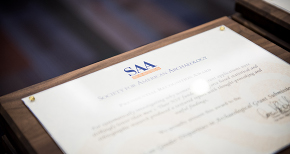SAA Minimum Qualifications and Experience for Rock Art Principal Investigators Guidelines (2018)
Rock art is a broad category of archaeological resource that encompasses many human modifications of the landscape for a variety of purposes. Rock art is found worldwide as paintings and engravings on rock surfaces (pictographs and petroglyphs). Rock art also includes geoglyphs, Indigenous modifications of the landscape with natural materials such as rocks, wood, and earth to create a representational figure or a geometric design.
Rock art is a fragile archaeological resource. Because nearly all known rock art sites are easily visible, they are especially prone to vandalism and disturbance. They are adversely affected by natural weathering and human caused air-pollution. Accordingly, rock art sites should be subject to clearly defined management strategies.
The following principles are intended as guidelines for dealing with rock art sites when they are encountered in the course of archaeological projects, including impact assessments and research. These principles provide recommendations for minimum qualifications for Principal Investigators. The guidelines are not a set of methods for recording, conservation, or preservation. In particular, any physical treatment, conservation, or alteration of any rock art resource for the purpose of preservation or restoration is a highly specialized activity that requires specifically trained individuals. This type of conservation work is not addressed in these guidelines.
Minimum Qualifications
The Society for American Archaeology, Rock Art Interest Group, recommends the following minimum qualifications and experience for Principal Investigators for rock art projects conducted under government contract, permit, or review from the federal to the local level. For example, in the United States that includes NHPA Section 106 and 110 compliance, as well as rock art research projects involving ARPA or any other Federal permitting or similar fieldwork authorizations. These standards are presented as minimum requirements that should be adhered to within the context of laws governing archaeological projects in other jurisdictions including the governments of Canada, Mexico, and the countries of Central and South America. The SAA does not adjudicate or enforce qualifications.
- A graduate degree in archeology, anthropology with an archaeological focus, or closely related field (as identified by the Register of Professional Archaeologists)combined with a minimum of two years of cumulative professional experience planning, directing,and completing one or more rock art research projects involving fieldwork, analysis,and professional reporting;
- One year of cumulative professional experience or equivalent specialized training in archeological research, administration, or management;
- Four months of supervised field and analytic experience in general North or South American rock art research and management;
- One year of cumulative professional experience at a supervisory level in the recording, documentation,and study of rock art resources;
- A demonstrated ability to carry field projects, analyses, syntheses, and recommendations to completion;
- Evidence of behavior consistent with the Register of Professional Archaeologists' Code of Conduct and Standards of Research Performance;
- Experience in respectfully engaging Native American and/or other culturally affiliated communities.
For projects involving NHPA Section 106 compliance or similar legislation in other countries, the Principal Investigator should have a minimum of six months experience conducting projects for regulatory compliance purposes, including evaluating historical properties for NRHP eligibility.
Recommended Standards for Rock Art Documentation
Rock art documentation,and subsequent management, is a series of actions applied to properties of archaeological and ethnographic interest. Documentation of such properties may occur at any or all levels of planning, identification,evaluation,and reporting. The nature and level of documentation is dictated by each specific set of circumstances associated with individual site characteristics and project parameters. Rock art documentation consists of activities such as archival research (i.e., gathering previous fieldwork records and publications on the site), observation and recording of above-ground and submerged remains, and observation and recording of surrounding landscape. Rock art documentation is employed for the purpose of gathering information on individual sites or groups of sites. It is guided by a framework of objectives and methods derived from a conservation and management planning process, and makes use of previous planning decisions, such as those on evaluation of significance and determinations of effect pursuant to Section 106 compliance or similar legislation in other countries.
Above all, documentation of rock art sites must be guided by the fundamental principle of causing no adverse impact to the site and to the associated rock art expressions.
Rock art documentation may be undertaken as an aid to various activities, including initial site recording, research, interpretation, and recommendations of mitigation options.
Every effort should be made to preserve rock art occurrences in place with a minimum of external interference or modification. “Do no harm” should be the operational objective of all projects that involve rock art. Conservation measures that involve direct contact with rock art should only be performed by trained specialists in this field.
Most if not all rock art sites in the Americas will be regarded as sacred places by local Indigenous people. Accordingly, it is important for rock art researchers/recorders to understand, appreciate, and provide commensurate documentation of the personal association and interpretation that many Indigenous people have with these sites.These places often are interpreted as physical validations of community heritage, are documented in oral histories, and figure prominently into collective identities of the relevant Indigenous people. Consultation with local Indigenous people regarding proper protocols for recording and documenting rock art sites is strongly encouraged.



